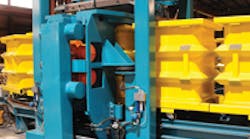Vulcan Engineering’s patented Vector-Flo® sand compaction system controls the media flow and compaction according to each part, and with precise repeatability. It uses four motors with a clamped flask, allowing the vibratory motor vectors to be adjusted to accommodate various programs of differing recipes while filling the flask with media.
The Lost Foam Casting Process has come a long way since its first in 1953 (but especially since the first real production line in 1980), and over the past 30 years there have been considerable improvements, both in basic materials and the improved design of the equipment.
Lost foam casting is unique, and for producing the right selection of castings, nothing matches it. In many instances, it would make sense to redesign a casting or add items to it (e.g., brackets) or to combine multiple parts into one casting, in order to achieve the advantages of lost foam casting. The process allows maximum flexibility for designs that, in most cases, are not possible in other casting processes.
Among the advantages of lost foam casting are:
- Neither additives, binders, nor cores are required.
- Scrap volumes are minimized; the equipment’s footprint is small; energy and manpower requirements, as well as insurance premiums are reduced; as are the machining and finishing requirements.
- Once installed, lost foam casting offers flexibility in casting design and is environmentally friendly.
In recent years, there have been changes not only in raw materials used for lost foam casting, but also various aspects of equipment improvements. Raw materials have changed in a couple of areas, notably with the introduction of modified raw beads for producing patterns and various co-polymer beads to assist the use with iron castings, and to reduce lustrous carbon.
Sand or Media — The introduction of synthetic sand produced in a ceramic form brings several different advantages, including more fluidity (and therefore, better compaction.) It’s also longer lasting, with minimum fines.
Coatings have been improved to give better control of coverage to the foam pattern and to assist in removing the gases from the polystyrene foam pattern.
An automated, 35-FPH aluminum molding line with a one-hour cooling time, and using a robot to extract finished castings.
The use of a robot for dipping the foam pattern cluster into the coating is preferred as it gives a more consistent coating application.
Sand Fill Hopper and Rain Gate — The sand fill hopper has been developed to ensure consistent use of the media. Previously, the correct amount of media was achieved either by weight or by time. The new, patented system precisely controls the media by volume, which guarantees consistency in the correct amount of media to be delivered to the flask.
Sand Fill and Compaction — Equipment for raining the media around the cluster must be precisely controlled and must be interlocked with the compaction system. The patented rain gate operates in three modes: fast, slow or stopped.
Vector-Flo® Compaction System — The new, patented Vector-Flo® Compaction Table System provides advanced control of media flow and compaction, which can be altered to fit each part and with precise repeatability. The compaction system uses four motors with a clamped flask, allowing the vibratory motor vectors to be adjusted to accommodate various programs of differing recipes while filling the flask with media. In fact, we can now ensure that sand flows “uphill” to completely compact blind holes, even at the base of the foam pattern. (We can arrange for a test unit to try the process for your product, so that customers can carry out detailed tests.)
Sand Cooling — We have redesigned the sand cooler to operate in the Lost Foam casting system. This cooler allows the sand to cascade through various sections of the cooler passing over water-cooled tubes. The tube bundles are designed for easy replacement, when necessary, with a minimum of down time.
Automation — Automation is playing a more important part in the Lost Foam Casting Process, to ensure consistency, reduce manpower and increase safety. For example, robots are used in several areas, for cluster insertion, molten metal pouring, and casting extraction.
Degating is being automated, too, which makes it more environmentally friendly, reduces the weight of castings, and improves operator safety. Cutting down the operator’s reach makes degating a much safer task.
For many cast products — cylinder heads, cylinder blocks, pipe fittings, valves, fire hydrants, motor starters, and more — the lost foam casting process is the perfect match.











